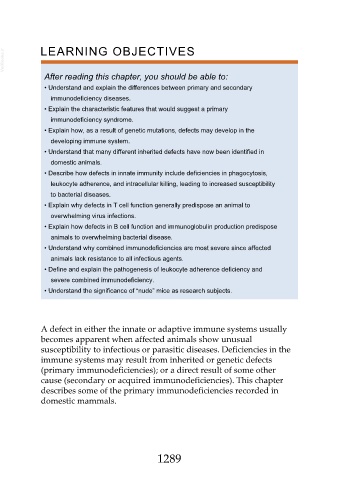Page 1289 - Veterinary Immunology, 10th Edition
P. 1289
VetBooks.ir LEARNING OBJECTIVES
After reading this chapter, you should be able to:
• Understand and explain the differences between primary and secondary
immunodeficiency diseases.
• Explain the characteristic features that would suggest a primary
immunodeficiency syndrome.
• Explain how, as a result of genetic mutations, defects may develop in the
developing immune system.
• Understand that many different inherited defects have now been identified in
domestic animals.
• Describe how defects in innate immunity include deficiencies in phagocytosis,
leukocyte adherence, and intracellular killing, leading to increased susceptibility
to bacterial diseases.
• Explain why defects in T cell function generally predispose an animal to
overwhelming virus infections.
• Explain how defects in B cell function and immunoglobulin production predispose
animals to overwhelming bacterial disease.
• Understand why combined immunodeficiencies are most severe since affected
animals lack resistance to all infectious agents.
• Define and explain the pathogenesis of leukocyte adherence deficiency and
severe combined immunodeficiency.
• Understand the significance of “nude” mice as research subjects.
A defect in either the innate or adaptive immune systems usually
becomes apparent when affected animals show unusual
susceptibility to infectious or parasitic diseases. Deficiencies in the
immune systems may result from inherited or genetic defects
(primary immunodeficiencies); or a direct result of some other
cause (secondary or acquired immunodeficiencies). This chapter
describes some of the primary immunodeficiencies recorded in
domestic mammals.
1289

